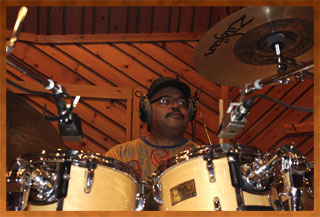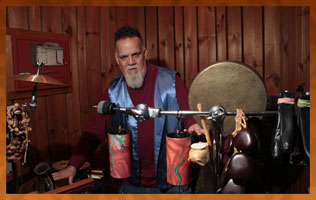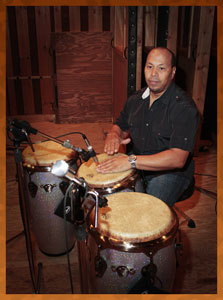

|
Soundclip:
|
| See Steve's Hand-Written Lead
Sheet |
|
Steve
Khan's
lead
sheet: It was always my plan to record this tune first, because I knew that it would give a clear group picture, and I would know immediately if we had the best possible recorded sound for the chordal passages, and the single-note line passages. One of the reasons that I wanted to work again with recording engineer James Farber was that the sound that he created for "CROSSINGS"('94) remains as my most beautifully recorded CD.  When I heard the rough mixes of this tune, I knew that we would be relatively close to that sound. However, there's a huge difference between the old Skyline Studios on the 6th Floor, and Avatar Studio 'A.' When I heard the rough mixes of this tune, I knew that we would be relatively close to that sound. However, there's a huge difference between the old Skyline Studios on the 6th Floor, and Avatar Studio 'A.'Of course, I had a very definite structural plan for this tune, with the idea being that, after the solo section and a final 'breakdown' section, we would play both parts of the melody, but only one time each. Then, the piece would fade out as I returned to soloing over the Bb blues form. Well, Bobby Allende had other ideas, and suggested that, after the final melody section, we should just play the breakdown figure that appears in letter [B], and Dennis Chambers would solo on the way out. I can't say that I loved that idea - structurally speaking - but I've learned to listen to my bandmates, and I just went with "the flow." What you now hear is exactly what happened. As always, Dennis played a great solo, and I left the performance completely intact. As you can hear, there is no fade. My impression now, after some listening to the performance, is that this piece best exemplifies what can happen when the looseness of the Eyewitness concept of music-making meets some of the most important elements of Latin music. You can hear the spirit of Manolo Badrena floating/darting in-and-out of the texture - just as it should, and as it has always been in the past. You can also hear the interplay, the level of communication between Anthony Jackson; Dennis; Manolo and me - this, of course, is hugely important!! Manolo is a most special and unique talent, one of the most visionary and intuitive musicians I have ever had the pleasure of working with. The sounds that he contributed to this tune are really brilliant and add so much. I know that it wasn't easy for him to have to let go of all the traditional sounds of Latin music and allow Marc and Bobby to handle those tones, but, on this performance, it really seemed as though Manolo totally understood what I was asking him to contribute. The atmosphere that he helped to spontaneously create could not have been done by anyone else. O.K., yes, perhaps someone like Airto or Naná could have done it their way. "Change Agent" is the first of three cha-cha-chas that appear on "PARTING SHOT." Over the years, when I have recorded any Latin tune that is a cha-cha, there's a particular cymbal bell pattern that I like the timbalero or the drummer to play.  In this case, as Marc Quiñones was going to be banging out quarter-notes on the cha-cha bell, I knew that this pattern would be perfect for Dennis to play. I first heard someone playing this cymbal bell beat on another Cal Tjader recording from 1965, "SOUL BIRD: WHIFFENPOOF"(Verve) - yes, that's the title! As there was no timbal on this track, and two drummers were listed: Grady Tate and Sol Gubin, I'm just going to venture a guess that my old friend Grady Tate played this beat. We had tried it at the rehearsal and it sounded great. But, just before the actual take, Dennis called out to me and said, "What was that bell of the cymbal pattern again?!?!?!" And so, I responded by saying, "It's spang-spang-spang-a-dang, spang-spang-spang-a-dang!" And, now you hear the results. On a historical note, that particular Cal Tjader album was engineered by the great Phil Ramone. In this case, as Marc Quiñones was going to be banging out quarter-notes on the cha-cha bell, I knew that this pattern would be perfect for Dennis to play. I first heard someone playing this cymbal bell beat on another Cal Tjader recording from 1965, "SOUL BIRD: WHIFFENPOOF"(Verve) - yes, that's the title! As there was no timbal on this track, and two drummers were listed: Grady Tate and Sol Gubin, I'm just going to venture a guess that my old friend Grady Tate played this beat. We had tried it at the rehearsal and it sounded great. But, just before the actual take, Dennis called out to me and said, "What was that bell of the cymbal pattern again?!?!?!" And so, I responded by saying, "It's spang-spang-spang-a-dang, spang-spang-spang-a-dang!" And, now you hear the results. On a historical note, that particular Cal Tjader album was engineered by the great Phil Ramone.Marc Quiñones' contributions to this tune, and the entire recording are so immense that I could easily run out of space singing his praises here. Everyone involved in Latin music knows that Marc possesses the greatest avanico in the music. Simply put, this is the little 'roll' that you hear leading into songs and setting-up a new section. More than this, Marc's musicianship is superb, and I can write out specific accents for him to catch, and I never worry about whether or not he'll be there - he's always there!!! And when he hits any crash, coupled with a timbal rimshot - it's like a gunshot has gone off in the room. Like most timbaleros, Marc always arrives with just one multi-purpose cymbal, this time he showed me a new one that Zildjian had made for him which has 3 distinct sounds. It was really interesting to hear them when he demonstrated it for me. But, knowing that he's only going to have one cymbal, I always come prepared with 3 extra cymbal colors that I feel, at any given moment, can help to color the music in a positive way. Those 3 cymbals are: [1] a Zildjian 10" Extra Thin Splash; [2] a K Zildjian 17" China w/ rivets; [3] an 18" Thin Flat Ride w/ rivets(this one is mostly for ballads).  As you hear Marc execute the written accents, these are the cymbal colors that you are hearing. For example, in letter [I], in bars 5, 10 & 12 and on the repeat, during the 2nd Ending, the very last bar before letter [A]. During [A], there are accents in bars 2, 5, and 12 on the repeat. As you hear Marc execute the written accents, these are the cymbal colors that you are hearing. For example, in letter [I], in bars 5, 10 & 12 and on the repeat, during the 2nd Ending, the very last bar before letter [A]. During [A], there are accents in bars 2, 5, and 12 on the repeat.After the single-note melody section, we arrive at the 1st appearance of letter [B], an 8-bar breakdown section, which appears as an interlude, and was inspired by something similar on the title track from Cal Tjader's influential recording, "SOUL BURST"(Verve), recorded in 1966, and that recording featured a very young, but exceptionally polished, Chick Corea. On the and-of-1 in bar 7, we begin a crescendo, which, in Spanish, is known as a levanta, all leads to Marc's avanico and the 12-bar blues format for guitar solo at letter [C] begins. In bar 5, Marc and Bobby created the 1st of two fantastic break figures with this one beginning on beat 3 of bar 5. These are the little percussive touches that are so unique and special to Latin music. Without the help and creativity of Marc and Bobby, I could never have come-up with such a thing by myself!!! No way!!! When [B2] reappears after the guitar solo, the levanta begins on beat 4 of bar 4, giving the entire break a completely different feeling. But, this time as we return to [I], in bar 8, Dennis, Marc and Bobby play 3 quarter-note triplets which begin on beat 3 of bar 8 and drive us beautifully back to the top of the tune. Obviously, when you have a Latin rhythm tandem like Marc Quiñones and Bobby Allende, you have two musicians, two dear friends, who really love playing together and have a musical understanding that makes everything so much easier for me - even when we don't seem to agree about something. But, what I love so much about paying with Bobby is that he is so concerned with the groove, with laying down a big tumbao, and that is so important to the feel of the overall music. In a time where so much emphasis is placed on virtuosity and not on the groove, I treasure Bobby's attention to making the music swing above all over things. His contributions to "Change Agent" are a perfect example of that. Again, the format for the guitar solo at [C] is a rather simple 12-bar Bb blues form. The only small twists in what would be considered 'standard' are that in Bar 4, we actually apply a ii-V over the b5 substitution, meaning Bm7-E7 before resolving to our IV7 chord of Eb7. The other touch is that bars 9-10 are played over an F-pedal which allows me much greater harmonic freedom, and of course, I enjoy that very much. This particular solo represents a goodly portion of the scope that I like to see in any improvisation. It feels relaxed to me. There's no sense of being in a hurry to 'arrive' somewhere in particular.  And best of all, for me, there is a representation of my particular 'comfort zone' of moving back and forth between single-note lines and chordal passages. Aside from the fact that this is the style I've been building for years, it always makes a firm connection to the two melodic sections of tune. That is also always very important to me. The improvisation should be an extension of melodic material heard during any melody! And best of all, for me, there is a representation of my particular 'comfort zone' of moving back and forth between single-note lines and chordal passages. Aside from the fact that this is the style I've been building for years, it always makes a firm connection to the two melodic sections of tune. That is also always very important to me. The improvisation should be an extension of melodic material heard during any melody!The Dennis Chambers drum solo over our breakdown figure at [B] is a real work of musical drumming art to me. The shape of the improvisation gives the listener a clear sense of a beginning, a middle, and an end. As Marc, Bobby and I hold things together for most of the time, Anthony and Manolo are free to create alternate harmonies and textures. And Dennis' solo grows and builds, I slowly leave the figure and begin to respond to what I'm hearing around me. One my favorite moments takes place at about 6:55 with the intensity really building and Dennis double-bass drum pedal episode coming, Manolo seems to be playing 'orchestra bells' that add such a special touch to the overall texture along with a sense of drama. Moments like that are just to be treasured, at least by me. As soon as the performance had ended, I knew that I would leave Dennis' solo in tact, no matter how long the track happened to be. After I learned that it was only a bit over 8-minutes long, there was nothing to worry about. As the overall drum sound is so crucial to any recording, I previously mentioned that James Farber and I were using the "CROSSINGS" recording as our sonic model, and that recording had been done at the old Skyline Studio on the 6th floor. The great drum sound that James and Dennis created had a great deal to do with the fact that Dennis had been placed in a decent size iso-booth with a relatively lower ceiling. "PARTING SHOT" was recorded in Studio 'A' @ Avatar and Dennis was placed out in the "big room" which has a very high ceiling. So, even with the microphones in similar positions the sound is going all over the place. I was hoping for a really tight, in your face, kind of drum sound. My error in planning was that, after everything had been recorded, James and I both felt that I would have gotten closer to the results that I had hoped for if Dennis and I had switched places and Dennis had gone into the iso-booth I had been in. Of course, "hindsight is 20/20" - or, "should'a-would'a-could'a"!!! On a side note, and this rarely, if ever, happens, the great John McLaughlin stopped by the studio that day to say "Hello!" to everyone, as he had been in town to tape a TV performance w/ The Roots on Jimmy Fallon's show. I think that the last time that I saw John was somewhere in Europe when I was touring with Anthony and Dennis. People have asked me about the title and where it comes from, and the answer is actually pretty simple. I keep a little list of potential song titles which consists of various terms or phrases that I might have heard and came to like. "Change Agent" was one of them that I wrote down during the 2008 presidential campaign. On all the various political discussion shows here, this term was often used to describe Barack Obama. As I don't really like mixing politics and music too much, and the fact that musicians are always talking about playing 'changes' - it seemed that any title that had the word 'change' in it would be a good thing. But, in the end, the title is not concretely linked to either reference.
[Photos: Dennis Chambers; Manolo Badrena; Marc Quiñones
and Bobby Allende
by: Richard Laird @ Avatar Studios, November 6-7, 2010.] |